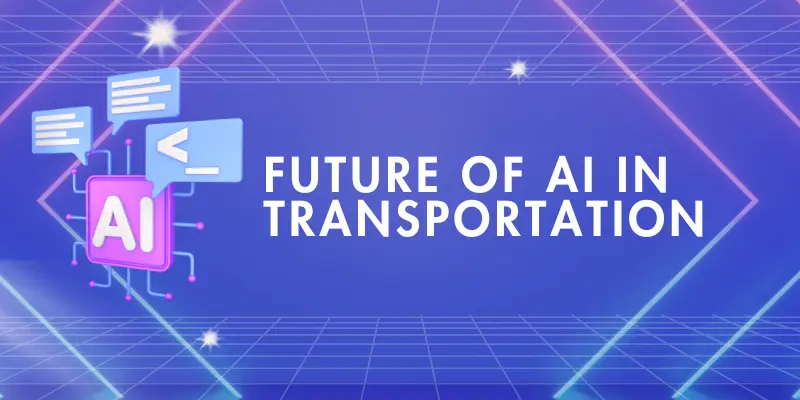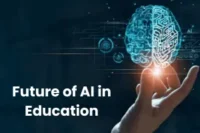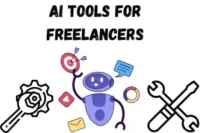AI in Transportation: The Future of Smart Mobility
Published: 27 Oct 2025
The quick development of artificial intelligence (AI) is driving the transformation of transportation. Travel is becoming safer, quicker, and more efficient thanks to artificial intelligence (AI), from self-driving automobiles to smart traffic lights. Imagine a society with fewer accidents, fewer traffic bottlenecks, and always on-time delivery. That is how AI can be used in transportation.
In this article, we will discuss the definition, operation, practical uses, advantages, and future of AI in transportation. Whether you’re a student, business owner, or simply interested in technology, this guide will give you clear answers and insights.
What is AI in Transportation?
AI in transportation refers to the application of intelligent technologies to enhance, accelerate, and secure travel. To make quick decisions, it processes data from sensors, cameras, and GPS using artificial intelligence. AI can assist, for instance, in determining the optimal bus and train routes, controlling traffic signals to minimize traffic jams, and enabling self-driving cars to operate without the need for human drivers.
It applies to all modes of transportation, including air, sea, rail, and roadways, not just automobiles. Time savings, fewer accidents, and more efficient mobility for all are the major objectives.
Real-World Applications of AI in Transportation
AI is not just a future concept; it’s already making transportation smarter and safer. Here are some real-life applications where AI is changing the way we travel:
- Self-Driving Cars: AI is used by businesses like Tesla to operate cars safely and effectively without the need for human assistance.
- Ride-Sharing Apps: Apps like Uber and Lyft use AI to match drivers with passengers and find the fastest routes.
- Smart Traffic Management: AI controls traffic lights and monitors roads to reduce jams and improve flow.
- Public Transport Optimization: AI enables smart ticketing, real-time vehicle tracking, and on-time operation of buses and trains.
- Logistics and Delivery: Companies such as Amazon use AI for delivery route planning, autonomous vehicles, and warehouse automation.
- Air and Rail Transport: AI predicts maintenance needs, schedules trains and flights, and improves passenger safety.
- Maritime Shipping: AI improves ship route planning and minimizes fuel usage, resulting in cost savings and environmental sustainability.
How AI Improves Road Safety
AI is playing a big role in reducing road accidents and making travel safer. It uses smart systems and real-time data to prevent mistakes that humans often make. Here’s how AI improves road safety:
- Accident Prevention Systems: AI-powered sensors and cameras detect challenges, people walking around, and other vehicles to help avoid crashes.
- Driver Assistance Features: Features like lane-keeping, automatic braking, and blind-spot detection help drivers stay alert and safe.
- Predictive Analytics: AI analyzes traffic data to predict accident-prone areas and suggest safer routes.
- Smart Traffic Lights: AI manages traffic signals in real time, minimizing the likelihood of incidents at crossings.
- Fatigue Monitoring: AI systems in vehicles track driver behavior and alert them if they show signs of tiredness or distraction.
- Emergency Response Support: In case of accidents, AI systems can automatically alert emergency services with location details.
AI in Public Transportation
Artificial intelligence is making public transportation faster, safer, and more dependable. It ensures that buses, trains, and other services function smoothly and on time. Here’s how AI improves public transportation:
- Smart Ticketing: Artificial intelligence enables contactless and digital ticketing systems for quick and easy payments.
- Real-Time Tracking: Passengers may track buses and trains live using AI-powered apps.
- Route Optimization: AI determines the best routes to avoid delays and save gasoline.
- Demand Prediction: Artificial intelligence forecasts peak travel hours and helps schedule changes to allow for more people.
- Maintenance Alerts: AI monitors vehicle conditions and forecasts repairs before they occur.
- Safety Monitoring: AI monitors crowded stations and vehicles using cameras for passenger safety.
AI and Traffic Management
Traffic jams waste time, gas, and money. AI is improving traffic management in cities by utilizing data and smart technology. Here’s how AI is transforming traffic management:
- Smart Traffic Lights: AI manages lights based on real-time traffic flow, minimizing traffic and wait times.
- Traffic Prediction: AI uses past and live data to predict traffic patterns and prevent bottlenecks.
- Accident Detection and Alerts: AI systems detect crashes rapidly and notify emergency services for a quicker response.
- Adaptive Signal Control: Traffic lights adapt automatically when there is heavy traffic in one direction.
- Navigation Assistance: AI-powered apps such as Google Maps recommend the quickest routes and help you avoid traffic congestion.
- Connected Vehicles: AI allows vehicles to connect as well as traffic systems, resulting in more efficient driving.
AI in Rail, Air, and Maritime Transport
Artificial intelligence is not limited to highways. It is also revolutionizing trains, airlines, and shipping to improve global transportation efficiency and safety. Here’s how AI is applied in various sectors:
AI in Rail Transport
- Smart Scheduling – AI creates train schedules to minimize delays and manage traffic on congested routes.
- Predictive Maintenance – Artificial intelligence anticipates when train parts need to be repaired, preventing malfunctions.
- Passenger Flow Management: AI analyzes crowds at stations and modifies services during peak hours.
AI in Air Transport
- Flight Route Optimization – AI finds the safest and most fuel-efficient flying routes.
- Luggage Handling: AI tracks luggage to reduce missing luggage cases.
- Safety and security – Artificial intelligence monitors airport security and swiftly detects potential threats.
AI in Maritime Shipping
- Automatic Ships – AI enables ships to move without human intervention on extended trips.
- Fuel Optimization: AI recommends routes that save fuel and lower pollutants.
- Port Operations: AI enhances cargo loading and unloading efficiency at ports.

Future of AI in Transportation
Artificial intelligence will make transportation smarter, safer, and more environmentally friendly. Experts believe AI is going to completely change the way people and things travel around the planet. Here’s what to expect in the following years:
- Fully Autonomous Vehicles: Self-driving vehicles, buses, and trucks will become increasingly prevalent on the road.
- Smart Cities with AI Traffic Systems: AI will control signals, manage traffic, and prevent accidents.
- Eco-Friendly Transportation: AI will aid in the design of energy-efficient routes, thereby reducing fuel consumption.
- AI in Flying Taxis and Drones: Air taxis and drone delivery will become commonplace.
- Advanced Safety Systems: Artificial Intelligence will predict and prevent accidents.
- Public Transportation Experience: Artificial intelligence will make buses, trains, and metros more reliable and comfortable.
- Global Shipping Automation: Autonomous ships and AI-powered logistics will accelerate global trade.
Challenges of Using AI in Transportation
AI is changing transportation, but it also presents major challenges. These difficulties make it difficult for businesses and governments to implement AI quickly. Here are the major challenges:
- High Implementation Cost: Developing AI systems, sensors, and networks involves a significant investment that many businesses cannot afford.
- Data Privacy Concerns: AI relies on gathering personal and traffic data, which, if improperly used or disclosed, can lead to major privacy violations.
- System Failures and Risks: AI is not perfect. If an error occurs, it might result in accidents or system failures, putting lives at risk.
- Cybersecurity Threats: Cybercriminals can hack AI-powered vehicles and traffic systems, resulting in dangerous conditions.
- Lack of Skilled Workforce: AI technology requires trained experts to design and maintain systems, yet qualified people are in short supply.
- Legal and ethical issues: The laws are still unclear. For example, who is liable if an AI-driven vehicle causes an accident?
- Public Trust and Acceptance: Many people are afraid to trust self-driving cars or AI systems, which limits their adoption.
Conclusion
AI is transforming how we travel, making it smarter, safer, and faster. AI has a wide-ranging impact, from self-driving cars to smart traffic systems. It helps to decrease accidents, save time, and enhance the whole travel experience. Of course, there are difficulties, but with the correct strategy, AI has the potential to significantly impact the future of transportation.
We hope this article helped you understand how AI is revolutionizing transportation. If you want to understand more about AI and other cutting-edge technologies, follow us for more informative articles. Your journey to smarter knowledge begins here!
Frequently Asked Questions [FAQs]
You may still have questions about how AI is transforming transportation. Don’t worry, we’ve answered some of the most common questions below to help you learn more:
It is an artificial intelligence and data-driven system for managing and improving transportation. It forecasts traffic, plans routes, and enables self-driving cars for safer and faster travel.
AI in transportation is using smart technologies and algorithms to improve travel safety, speed, and efficiency. It has applications in self-driving automobiles, traffic control, public transportation, and logistics.
AI uses sensors, cameras, and real-time data to prevent accidents, alert drivers, and control traffic lights. It can also detect risks and send emergency alerts if an accident happens.
AI will shape future transport with self-driving vehicles, smart traffic systems, flying taxis, eco-friendly routes, and fully automated logistics for faster and safer travel.
Public Transit Optimization: AI improves public transportation by forecasting demand, changing schedules, and providing better passenger experiences. Smart Facilities: AI-powered road monitoring systems detect risks, automate toll collection, and boost overall transport efficiency.

- Be Respectful
- Stay Relevant
- Stay Positive
- True Feedback
- Encourage Discussion
- Avoid Spamming
- No Fake News
- Don't Copy-Paste
- No Personal Attacks

- Be Respectful
- Stay Relevant
- Stay Positive
- True Feedback
- Encourage Discussion
- Avoid Spamming
- No Fake News
- Don't Copy-Paste
- No Personal Attacks





